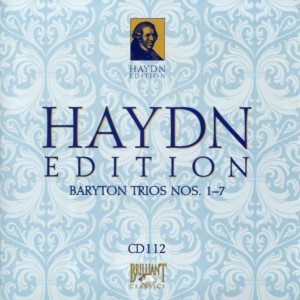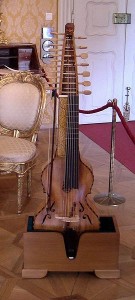 I remember seeing the phrase “Baryton Trios” many times over the course of my life.
I remember seeing the phrase “Baryton Trios” many times over the course of my life.
Until this morning, I thought Baryton was a place, a city perhaps. Like Berlin. Or Vienna. Or London.
Now I know baryton is the name of an instrument that looks somewhat like a viola or cello. (Photo below from this source.)
 So a Baryton trio is an ensemble of three musicians named for the lead instrument – the baryton.
So a Baryton trio is an ensemble of three musicians named for the lead instrument – the baryton.
Hey, look. I told you I wasn’t a musicologist. That’s why I take on these types of projects. I love music and I love to learn.
Here are some excerpts about the baryton from this article on Wikipedia:
The baryton is a bowed string instrument which shares some characteristics with instruments of the viol family, distinguished by an extra set of plucked strings. It was in regular use in Europe up until the end of the 18th century.
The baryton can be viewed as a sort of augmented bass viol. It is similar in size to the latter instrument and likewise has six or seven strings of gut, arranged over a fretted fingerboard and played with a bow. The instrument is held vertically and is supported by the player’s legs (rather than with an endpin as in the modern cello).
The baryton differs from the bass viol in having an additional set of wire strings. These perform two functions: they vibrate sympathetically with the bowed strings, enriching the tone, and they can also be plucked by the left thumb of the performer, creating a contrasting tonal quality.
The baryton was “completely neglected” (Hsu) in the nineteenth century, but in the twentieth, with the rise of the authentic performance movement in classical music, new barytons were built and played.
According to the Oxford English Dictionary, the name of the instrument is a loan word from French baryton or Italian baritono, and ultimately derives from Greek bary- + tonos ‘deep-pitched’. Alternate spellings include: bariton, barydon, paradon, paridon, pariton, viola paradon, viola di bordoni, [Italian] viola di bardone, [German] viola di bordone.
Here are some excerpts about Haydn’s Baryton Trios from this article on Wiki:
Joseph Haydn wrote 123 trios for the combination of baryton, viola, and cello. In addition, there are three trios (H. XI:89-91) for baryton, cello, and violin; considered part of the same series. As Sisman notes, they are “the most intensively cultivated genre of Haydn’s earlier career.”
Haydn began composing baryton trios in 1765. At the time he had been working for the princes of the Esterházy family since 1761, and since 1762 for the newly reigning Prince Nikolaus. Nikolaus had previously played the viola da gamba (an instrument similar to the baryton, but without the sympathetic strings), but in 1765 he purchased a baryton. In the same year, Haydn received an official reprimand from the prince for neglecting his duties; for details of this episode see Gregor Werner. An addendum to the reprimand specified that Haydn should also spend more time composing works for the Prince’s new instrument:
“Finally, said Capelmeister Haydn is urgently enjoined to apply himself to compositions more diligently than heretofore, and especially to write such pieces as can be played on the gamba [i.e., baryton], of which pieces we have seen very few up to now; and to be able to judge his diligence, he shall at times send us the first copy, cleanly and carefully written, of each and every composition.”Haydn responded vigorously to this command, and his efforts soon met with the Prince’s approval. On 4 January 1766, Esterházy wrote to his administrator:
“I have this moment received from Hayden [sic] three pieces which please me very much. You are accordingly to pay him in my name twelve ducats from the treasury and to tell him at the same time that he is to write six more pieces like those he has just sent me, together with two solos, to be delivered as soon as possible.”
The trios, being written for amateur performance, are generally shorter and less ambitious than the Haydn’s more famous series of symphonies and string quartets. In almost all cases, they consist of just three movements. When there is a slow movement, it is usually the first movement and is followed by a second movement in fast tempo. The first movement can also be a fast-tempo work in sonata form, or sometimes a variation set. There is always a minuet, which is placed either as the middle movement or as the finale. Non-minuet finales are characteristically in fast tempo.
In general, the first and last movements are in the home key of the trio and the middle movement in a closely related key. Only two of the trios are in a minor key.
Sounds like the Prince was a dick. He had a gamba (baryton) so he wanted Haydn to quick whip up a bunch of songs that could be played on the baryton.
Here are the members of the Esterhazy Ensemble playing today’s Baryton Trios:
Michael Brussing baryton
Andras Bolyki viola
Maria Andrasfalvy-Brussing cello
I had more fun researching what a baryton is – and how big of a dick Prince Esterhazy was – than I did listening to these trios. I found these seven compositions to be monotonous.
But your mileage may vary.
Here’s what I listened to this morning. NOTE: All were composed between 1765 and 1773. Haydn was 33 – 41 years of age.
Haydn Baryton Trio No. 1 in A
Haydn Baryton Trio No. 2 in A
Haydn Baryton Trio No. 3 in A
Haydn Baryton Trio No. 4 in A
Haydn Baryton Trio No. 5 in A
Haydn Baryton Trio No. 6 in A
Haydn Baryton Trio No. 7 in A
Obviously, Haydn liked the key of A for these trios.
